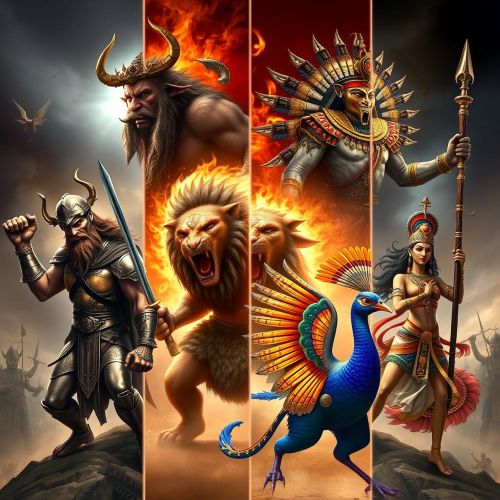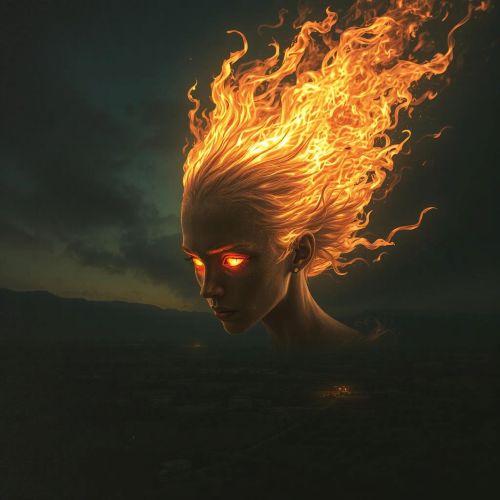Kuri : The Mischief Maker
Listen
At a glance
| Description | |
|---|---|
| Origin | Hausa Mythology |
| Classification | Gods |
| Family Members | Magaji (Father), Maguzhi (Brother), Gizo (Son), |
| Region | Niger, Nigeria |
| Associated With | Shapeshifting, Mischief |
Kuri
Introduction
Kuri’s origins reside in the mists of Hausa creation myths. He is often described as the firstborn son of Magaji, the supreme sky god, and sometimes associated with Janaaru, the earth goddess. Though considered a god, Kuri exists within the earthly realm, interacting directly with humans, unlike his more distant celestial father. His tales, passed down through generations of Hausa griots (oral historians), form a rich repertoire of folktales, songs, and proverbs, offering both amusement and moral lessons.
Within Hausa mythology, Kuri is identified as a male spirit. The Hausa people, a predominant ethnic group located mainly in northern Nigeria, stand as one of the largest ethnic communities in West Africa. The richness of their culture is evident in the profound integration of mythology, beliefs, and rituals into their daily lives. This integration paints a vibrant and diverse cultural landscape, steeped in spiritual significance. Revered across the northern regions of Nigeria and extending into parts of Niger, Kuri serves as a symbolic representation of the inherent duality within human nature, gracefully navigating between benevolence and deceit, laughter and chaos.
Physical Traits
Kuri showcases unparalleled mastery as a shapeshifter, seamlessly transitioning between human and animal forms. His favored appearance manifests as a strikingly handsome young man, adorned in intricate clothing and jewelry. Yet, his transformative abilities extend beyond the humanoid; Kuri effortlessly assumes the guise of diverse creatures, ranging from a dog or hyena to a bird, or even embodying natural forces like wind or fire. This remarkable fluidity serves as a testament to his capricious nature, allowing him to traverse the borders that separate different realms seamlessly.
In artistic representations, Kuri is often portrayed with the distinctive traits of a canine, emitting barks reminiscent of a dog’s vocalizations while draped in a goat-skin garment. This portrayal might draw influence from the baboon, known for its barking calls, or possibly find inspiration in Kure, a male hyena, adding layers of symbolism and mystery to Kuri’s enigmatic character.
Family
Kuri’s familial connections form an intricate tapestry of alliances and conflicts. As the offspring of Magaji, he enjoys a privileged position within the celestial hierarchy. However, Kuri’s penchant for mischief frequently places him at odds with his divine relatives. Among his noteworthy siblings, Maguzhi, the god of agriculture and fertility, stands out for his responsible demeanor, creating a noticeable contrast with Kuri’s playful and chaotic nature.
Expanding his familial lineage, Kuri is the progenitor of numerous offspring, each inheriting a fragment of his mischievous essence. Notable among his children are Gizo, personifying the embodiment of lightning, and Bakana, who assumes the role of the lord of the hunt. The diverse attributes and responsibilities of Kuri’s progeny reflect the multifaceted influence of the trickster spirit within the celestial and natural realms.
Other names
In addition to being recognized as Kuri, this spirit is also acknowledged by the name Rago. The term “Rago” likely serves as an alternate representation of the same entity, existing in diverse regions or contextual interpretations within Hausa culture. The various names associated with Kuri underscore the complexity of his character. Referred to as Rago, translating to “playful” or “deceitful,” these epithets illuminate his trickster persona. Other aliases include Gurum-Gurum, signifying the “rumbler” in connection to his association with earthquakes, and Dan Yarab, denoting the “son of the earth” to underscore his earthly ties. Each appellation contributes a unique layer to the intricate identity woven into the fabric of Kuri’s being.
Powers and Abilities
Although the precise powers and abilities of Kuri remain somewhat ambiguous in the available sources, the spirit is linked to specific animalistic characteristics, notably the ability to emit dog-like barks. Kuri’s range of powers is as diverse as his adeptness in shapeshifting. Demonstrating immense magical prowess, he commands control over the elements, crafts illusions, and manipulates the threads of fate. His astute intellect enables the formulation of intricate pranks and schemes, often surpassing the cleverness of even the most formidable figures.
Despite Kuri’s inclination towards mischief, there exists a dual aspect to his character. In moments of benevolence, he harnesses his formidable powers for virtuous endeavors, shielding mortals from harm and reinstating equilibrium to the world. This nuanced interplay of Kuri’s abilities underscores the multifaceted nature of this enigmatic spirit within the realm of Hausa mythology.
Modern Day Influence
The lasting influence of Kuri and various facets of Hausa mythology remains embedded in the ongoing cultural traditions of the Hausa people. Despite the widespread adoption of Islam, a predominant monotheistic faith, certain pre-Islamic beliefs, such as the reverence for spirits like Kuri, persist, serving as a poignant testament to the enduring historical legacy of the Hausa community. The narrative surrounding Kuri endures through the passage of generations, acting as a guardian of the vibrant, diverse, and spiritually enriched culture intrinsic to the Hausa people. These tales, handed down through time, serve as a preservative force, emphasizing the significance of laughter, resourcefulness, and the interconnectedness of all aspects of existence.
Beyond oral traditions, the image of Kuri transcends into contemporary expressions of Hausa culture, finding a place in art, music, and literature. This integration highlights the enduring cultural significance of Kuri, reinforcing his presence as a symbol of cultural continuity and resilience. In a rapidly evolving world, Kuri’s depiction in various forms of artistic expression serves as a poignant reminder of the Hausa people’s rich heritage and their ability to seamlessly blend the old with the new, fostering a cultural landscape that is both dynamic and deeply rooted in tradition.
Frequently Asked Questions
What is lorem Ipsum?
I am text block. Click edit button to change this text. Lorem ipsum dolor sit amet, consectetur adipiscing elit. Ut elit tellus, luctus nec ullamcorper mattis, pulvinar dapibus leo.
What is lorem Ipsum?
I am text block. Click edit button to change this text. Lorem ipsum dolor sit amet, consectetur adipiscing elit. Ut elit tellus, luctus nec ullamcorper mattis, pulvinar dapibus leo.
What is lorem Ipsum?
I am text block. Click edit button to change this text. Lorem ipsum dolor sit amet, consectetur adipiscing elit. Ut elit tellus, luctus nec ullamcorper mattis, pulvinar dapibus leo.
What is lorem Ipsum?
I am text block. Click edit button to change this text. Lorem ipsum dolor sit amet, consectetur adipiscing elit. Ut elit tellus, luctus nec ullamcorper mattis, pulvinar dapibus leo.
What is lorem Ipsum?
I am text block. Click edit button to change this text. Lorem ipsum dolor sit amet, consectetur adipiscing elit. Ut elit tellus, luctus nec ullamcorper mattis, pulvinar dapibus leo.



